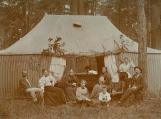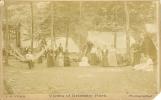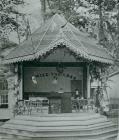1
In 1846 a large outdoor temperance meeting, called a 'soiree', was held just east of the Hamlet of Grimsby. Harriet Phelps Youmans in her book, Grimsby Park Historical and Biographical Sketches, writes, "it was held on the high bank in front of the home of Samuel Russ, Esq., which stood near the present Lake View House. There were long tables bounteously spread, at which the great assembly feasted together. There were over two thousand persons present to enjoy the programme of band music and speeches from the eloquent men who graced the platform. Two of them belonged to the famous Ryerson family."3
Portion of 1862 Tremaine's Map showing location of the temperance meeting held in 1846 on the property of Samuel Russ.5
The Niagara District of the Methodist Church was established following the division of the Hamilton District. The Reverend Samuel Rose of Thorold was the first chairman. In 1859, the Niagara District committee met at John B. Bowslaugh's home and the Grimsby Camp meeting was established. Attending this meeting were the Reverend John Wakefield, the Reverend John Shaw, John Beamer Bowslaugh, the Reverend Samuel Rose, David Houser, the Reverend Michael Fawcette and Jacob Beamer. These men were to become known as the "Fathers of Grimsby Park".7
One of the decisions made at the 1859 meeting was to establish a permanent site for the annual summer camp meeting. John Beamer Bowslaugh's property, situated just east of the 1846 temperance camp meeting, was chosen. Many things were considered in the selection of this spot. It was on the banks of Lake Ontario and had suitable grounds, good water from a spring, available pasture for horses and plenty of wood for fires. The grounds were thickly covered with fallen trees and brush and required a great deal of work to ready it for a camp meeting.Beginning on the last Thursday of August, the ministers and laymen worked together to prepare the site for the 1859 meeting. Volunteers turned out in large numbers with their teams of horses to draw the lumber for the tent floors and to build a preachers' stand and seats. Light-stands and platforms were built, the canvas tents erected and wood and stumps were gathered for firewood. To celebrate the first gathering, Reverend Wakefield gave the inaugural sermon.
9
At this first gathering, a single tent could be rented for $2.50 and a double tent for $3.50.11
As long as Grimsby Park was owned by the Ontario Methodist Church Camp Ground Company, tents were available to rent. The tents were priced by size (small, medium and large) and were pitched in the grove located on the west side of the campground near the lake. The grove was accessed by crossing a footbridge.12
Following the success of the Grimsby Camp Meeting (1859), which lasted approximately one week, the meeting became an annual gathering in Grimsby. The exception was 1862 when it was held in Drummondville near Niagara Falls.The meetings resumed in Grimsby in 1863 but the accommodations were very primitive. Camp meetings were usually held the last week of August beginning on Thursday and lasting to the following Wednesday. Sunday was the most important day and the crowds were immense. In addition to the three regular services of sermons, meetings were held afterwards to allow for religious discussions. The woods and the road leading into the campground were filled with teams of horses and wagons. The people brought baskets of food and picnicked in the woods or on the shore. During the services the seats in the Auditorium were filled to capacity and hundreds more people stood, often extending as far back as the tents.
Arrangements were made for the Great Western Railway (the Grand Trunk Railway, 1882), which passed through the campground to include a stop at Grimsby Park. This provided a great convenience for many people who came long distances to stay at the camp. At first the train stopped briefly while passengers unloaded their baggage. Later a proper platform was built. Travellers had to find their way to the opening in the rail fence and follow the rough road that wound its way through the thick woods to get to the Campground.





